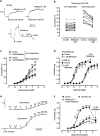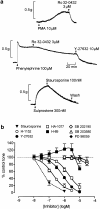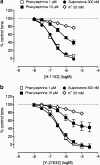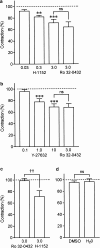Involvement of Rho-kinase in contraction of guinea-pig aorta induced by prostanoid EP3 receptor agonists
- PMID: 12922932
- PMCID: PMC1573987
- DOI: 10.1038/sj.bjp.0705393
Involvement of Rho-kinase in contraction of guinea-pig aorta induced by prostanoid EP3 receptor agonists
Abstract
1. The mechanism of contraction of guinea-pig isolated aorta induced by the prostanoid EP(3) receptor agonist sulprostone (0.1-300 nM) has been investigated. In 60% of the experiments, the sulprostone log concentration-response curve (maximum=15-40% of 100 nM U-46619 response; low-responders) was unaffected by the removal of extracellular Ca(2+), blockade of L-type Ca(2+) channels with nifedipine and depletion of internal Ca(2+) stores. In the remaining preparations (35-65% of 100 nM U-46619 response; high-responders), contractions to higher sulprostone concentrations showed a nifedipine-sensitive component, which was enhanced by charybdotoxin. 2. In Ca(2+)-free Krebs solution, established contractions to 300 nM sulprostone were abolished by the Rho-kinase inhibitors H-1152, Y-27632 and HA-1077 (IC(50) values=190, 770 and 2030 nM). The PKA/Rho-kinase inhibitor H-89 (10 nM-10 micro M) caused enhancement progressing to inhibition. The selective PKC inhibitor Ro 32-0432 (3 micro M) had no effect, while staurosporine, recently shown to be a potent Rho-kinase inhibitor, abolished sulprostone responses (IC(50) approximately 47 nM), but its action was slow. The MAP kinase inhibitors SB 202190, SB 203580 and PD 80958 produced little inhibition. 3. In normal Krebs solution, H-1152 and Y-27632 abolished established contractions to 300 nM sulprostone and 1 micro M phenylephrine, and partially inhibited 10 micro M phenylephrine and 50 mM K(+) responses. 4. The results are discussed in relation to the reported potencies of the protein kinase inhibitors in enzyme assays. Activation of the Rho-kinase pathway appears to be a primary mechanism of contraction induced by EP(3) receptor agonists in guinea-pig aorta.
Figures






Similar articles
-
Characterization of a prostanoid EP3-receptor in guinea-pig aorta: partial agonist action of the non-prostanoid ONO-AP-324.Br J Pharmacol. 1998 Nov;125(6):1288-96. doi: 10.1038/sj.bjp.0702189. Br J Pharmacol. 1998. PMID: 9863659 Free PMC article.
-
Synergism between prostanoids and other vasoactive agents.J Card Surg. 2002 Sep-Oct;17(5):436-8. doi: 10.1111/j.1540-8191.2001.tb01174.x. J Card Surg. 2002. PMID: 12630545
-
Investigation of the pronounced synergism between prostaglandin E2 and other constrictor agents on rat femoral artery.Prostaglandins Leukot Essent Fatty Acids. 2006 Jun;74(6):401-15. doi: 10.1016/j.plefa.2006.04.002. Prostaglandins Leukot Essent Fatty Acids. 2006. PMID: 16737803
-
E-ring 8-isoprostanes inhibit ACh release from parasympathetic nerves innervating guinea-pig trachea through agonism of prostanoid receptors of the EP3-subtype.Br J Pharmacol. 2004 Feb;141(4):600-9. doi: 10.1038/sj.bjp.0705648. Epub 2004 Jan 26. Br J Pharmacol. 2004. PMID: 14744812 Free PMC article.
-
Roles of stretch-activated cation channel and Rho-kinase in the spontaneous contraction of airway smooth muscle.Eur J Pharmacol. 2006 Dec 15;552(1-3):135-42. doi: 10.1016/j.ejphar.2006.08.067. Epub 2006 Sep 8. Eur J Pharmacol. 2006. PMID: 17026989
Cited by
-
Role of contractile prostaglandins and Rho-kinase in growth factor-induced airway smooth muscle contraction.Respir Res. 2005 Jul 27;6(1):85. doi: 10.1186/1465-9921-6-85. Respir Res. 2005. PMID: 16048647 Free PMC article.
-
Diverse effects of prostaglandin E₂ on vascular contractility.Heart Vessels. 2014 May;29(3):390-5. doi: 10.1007/s00380-013-0374-6. Epub 2013 Jun 9. Heart Vessels. 2014. PMID: 23748433
-
PGE2-EP3 signaling exacerbates intracerebral hemorrhage outcomes in 24-mo-old mice.Am J Physiol Heart Circ Physiol. 2016 Jun 1;310(11):H1725-34. doi: 10.1152/ajpheart.00638.2015. Epub 2016 Apr 15. Am J Physiol Heart Circ Physiol. 2016. PMID: 27084388 Free PMC article.
-
Protein kinase C delta contributes to increase in EP3 agonist-induced contraction in mesenteric arteries from type 2 diabetic Goto-Kakizaki rats.Pflugers Arch. 2012 Apr;463(4):593-602. doi: 10.1007/s00424-012-1088-9. Epub 2012 Feb 28. Pflugers Arch. 2012. PMID: 22371141
-
Investigation of the prostacyclin (IP) receptor antagonist RO1138452 on isolated blood vessel and platelet preparations.Br J Pharmacol. 2006 Sep;149(1):110-20. doi: 10.1038/sj.bjp.0706841. Epub 2006 Jul 31. Br J Pharmacol. 2006. PMID: 16880763 Free PMC article.
References
-
- ABRAMOVITZ M., ADAM M., BOIE Y., CARRIÈRE M.-C., DENIS D., GODBOUT C., LAMONTAGNE S., ROCHETTE C., SAWYER N., TREMBLAY N.M., BELLEY M., GALLANT M., DUFRESNE C., GAREAU Y., RUEL R., JUTEAU H., LABELLE M., OUIMET N., METTERS K.M. The utilization of recombinant prostanoid receptors to determine the affinities and selectivities of prostaglandins and related analogs. Biochim. Biophys. Acta. 2000;1483:285–293. - PubMed
-
- ALESSI D.R., CUENDA A., COHEN P., DUDLEY D.T., SALTIEL A.R. PD 98059 is a specific inhibitor of the activation of mitogen-activated protein kinase kinase in vitro and in vivo. J. Biol. Chem. 1995;270:27489–27494. - PubMed
-
- ARNER A., PFITZER G. Regulation of cross-bridge cycling by Ca2+ in smooth muscle. Rev. Physiol. Biochem. Pharmacol. 1999;134:63–146. - PubMed
-
- AUDOLY L.P., TILLEY S.L., GOULET J., KEY M., NGUYEN M., STOCK J.L., MCNEISH J.D., KOLLER B.H., COFFMAN T.M. Identification of specific EP receptors responsible for the hemodynamic effects of PGE2. Am. J. Physiol. 1999;277:H924–H930. - PubMed
Publication types
MeSH terms
Substances
LinkOut - more resources
Full Text Sources
Research Materials
Miscellaneous

